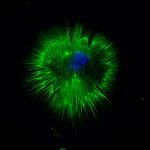Link to Pubmed [PMID] – 22110056
Development 2011 Dec;138(24):5403-14
The inner ear and cochleovestibular ganglion (CVG) derive from a specialized region of head ectoderm termed the otic placode. During embryogenesis, the otic placode invaginates into the head to form the otic vesicle (OV), the primordium of the inner ear and CVG. Non-autonomous cell signaling from the hindbrain to the OV is required for inner ear morphogenesis and neurogenesis. In this study, we show that neuroepithelial cells (NECs), including neural crest cells (NCCs), can contribute directly to the OV from the neural tube. Using Wnt1-Cre, Pax3(Cre/+) and Hoxb1(Cre/+) mice to label and fate map cranial NEC lineages, we have demonstrated that cells from the neural tube incorporate into the otic epithelium after otic placode induction has occurred. Pax3(Cre/+) labeled a more extensive population of NEC derivatives in the OV than did Wnt1-Cre. NEC derivatives constitute a significant population of the OV and, moreover, are regionalized specifically to proneurosensory domains. Descendents of Pax3(Cre/+) and Wnt1-Cre labeled cells are localized within sensory epithelia of the saccule, utricle and cochlea throughout development and into adulthood, where they differentiate into hair cells and supporting cells. Some NEC derivatives give rise to neuroblasts in the OV and CVG, in addition to their known contribution to glial cells. This study defines a dual cellular origin of the inner ear from sensory placode ectoderm and NECs, and changes the current paradigm of inner ear neurosensory development.

